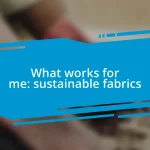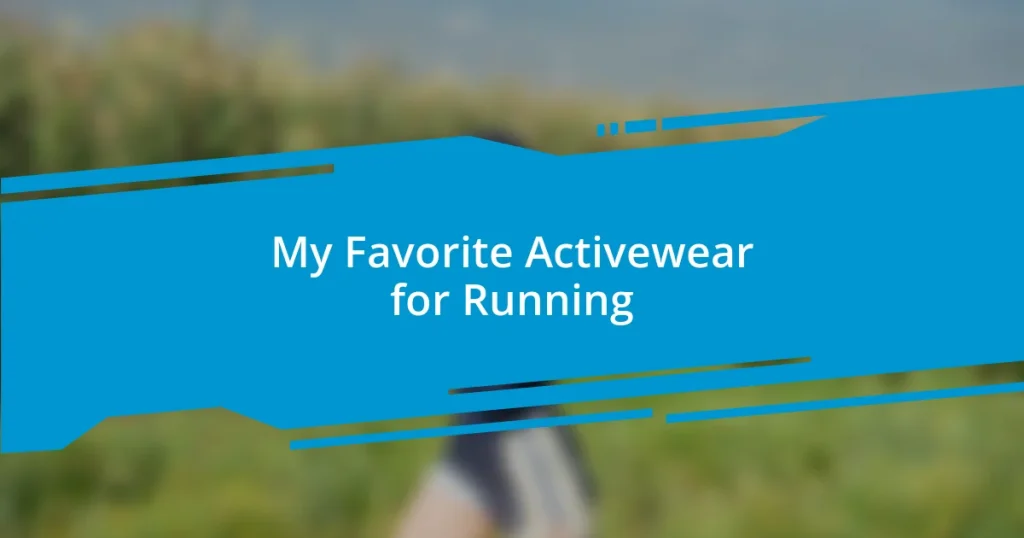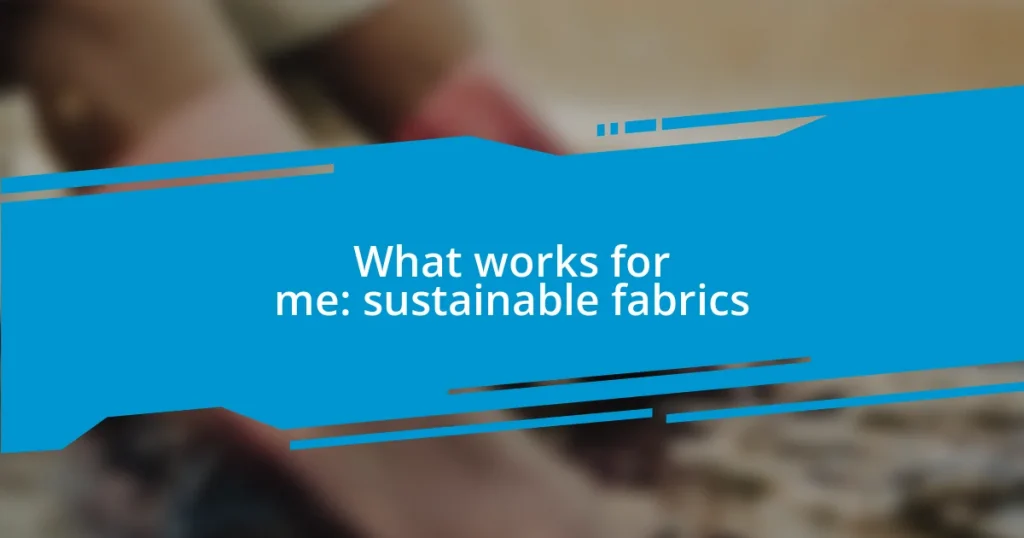Key takeaways:
- Breathability, moisture-wicking technology, and ideal fit are essential features for running activewear to enhance comfort and performance.
- Popular materials like polyester, merino wool, and spandex offer various benefits such as moisture management, temperature regulation, and flexibility for runners.
- Proper care, including detergent choice and air drying, as well as understanding sizing differences across brands, are crucial for maintaining activewear longevity and fit.

Top Features of Running Activewear
When it comes to running activewear, breathability is essential. I remember one particularly hot summer day when I opted for a lightweight tank top. The moment I stepped outside, I felt the air flowing through the fabric, keeping me cool even as my heart raced. Isn’t it amazing how the right materials can make such a difference in your comfort and performance?
Another crucial feature is moisture-wicking technology. I’ll never forget a rainy run when I wore my new running tights that just seemed to evaporate the sweat. Instead of feeling weighed down, I felt light and agile, almost like I was gliding along the pavement. Have you had a similar experience where the right gear completely transformed your workout?
Lastly, let’s talk about fit. It’s not just about looking good; it’s about how the clothes move with you. I’ve tried leggings that whispered “freedom” as I sprinted, and others that felt restrictive and claustrophobic. Have you ever found a piece of activewear that just “clicked” with your body? The right fit can boost confidence and let you focus purely on your run.
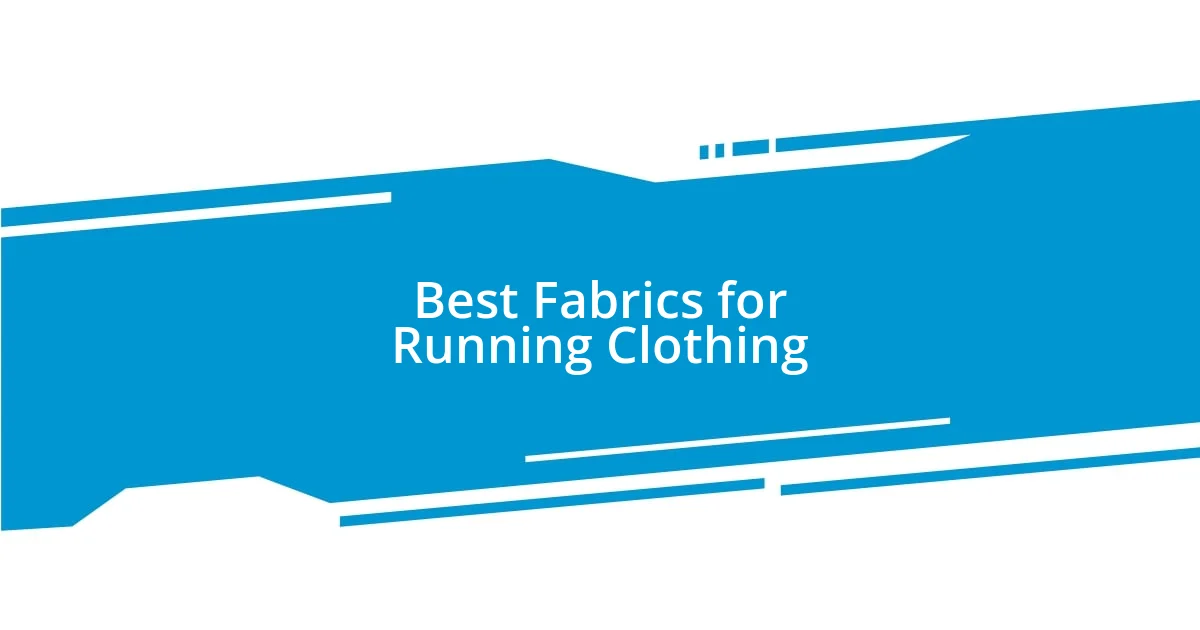
Best Fabrics for Running Clothing
When selecting the best fabrics for running clothing, I often turn to synthetic materials like polyester and nylon. These fabrics are fantastic at wicking moisture away from your skin, which is essential during those intense, sweat-drenching runs. I can still recall the first time I wore a polyester blend on a long-distance run; the way it clung to my body without becoming soggy was a game changer for my comfort.
Another fabric I swear by is merino wool. While it sounds counterintuitive for summer, this natural fiber is surprisingly breathable and regulates temperature. Once, while training in varying weather, I donned a merino wool shirt, and I discovered that it kept me comfortable, whether I was battling wind or basking in the sun. Have you ever felt that perfect blend of warmth and coolness? It’s like having your own climate-controlled running buddy.
Lastly, I can’t overlook spandex! It provides that snug fit without sacrificing mobility. I’ve experienced the freedom that comes from a good spandex blend—whether running a quick mile or powering through a marathon, it kept my muscles supported and ready for action. Leaving behind any discomfort is essential, right? That’s why I’ve decided that my go-to gear must always include a touch of spandex for that unrestrictive feel.
| Fabric | Benefits |
|---|---|
| Polyester | Excellent moisture-wicking, lightweight |
| Nylon | Durable, quick-drying |
| Merino Wool | Temperature regulating, breathable |
| Spandex | Flexible, supportive fit |

Ideal Fit for Running Gear
Finding the ideal fit for running gear is more than just aesthetics; it’s about how the clothing feels and performs during my runs. I recall a memorable jog where I decided to wear a pair of new shorts that promised a relaxed fit. To my surprise, they hugged my body just right without constricting me, allowing me to maneuver effortlessly. There’s a unique joy in discovering that perfect balance between snug and comfy—it’s almost like the piece was tailored just for me.
Here’s what to keep in mind when searching for that perfect fit:
- Size Matters: Ensure your activewear isn’t too tight or excessively loose. An ideal size helps prevent chafing and irritation.
- Length of Shorts/Leggings: Experiment with different lengths to see what you’re most comfortable with. Personally, I appreciate a mid-length short that offers both coverage and freedom.
- Waistband Design: A comfortable waistband can make or break your experience. I prefer a wide, soft waistband that sits snugly without digging in.
- Fabric Stretch: Look for stretchy materials that move with you. I find that 4-way stretch fabric allows for a fuller range of motion, which is vital on my longer runs.
- Seam Placement: Flat seams minimize chafing and increase comfort. I remember a time when I wore a top with poorly placed seams, which made finishing my run rather unpleasant.
By focusing on these aspects, you can enhance not only your comfort but also your overall running performance. Trust me, when you finally find pieces that fit just right, it feels like you can conquer any distance.

Essential Running Accessories to Consider
When it comes to running, having the right accessories can truly elevate the experience. A quality pair of running socks is a game changer—I still vividly remember the day I switched to moisture-wicking socks. They kept my feet dry and blister-free during a particularly grueling five-miler. Have you ever experienced that annoying itch of sweat-soaked socks? Trust me, investing in a good pair can make all the difference.
Another accessory I find indispensable is a reliable water bottle or hydration pack. On those hot summer runs, I once left the house without hydration, thinking I’d be fine. Boy, was I wrong! Halfway through, I was parched and regretting that decision. Now, I never hit the pavement without my trusty hydration gear. It not only keeps me refreshed but also gives me peace of mind knowing I can stay hydrated no matter how far I go.
Lastly, a good pair of running sunglasses is essential, especially to shield those eyes from harsh sun rays and glare. I recall a sunny morning run where the light seemed blinding. I quickly realized that my previous cheap pair didn’t cut it; they slipped and didn’t provide adequate UV protection. Since upgrading to a pair with a snug fit and polarized lenses, I feel a lot more comfortable and focused on my stride. Have you tried running sunglasses? The right pair can transform your outdoor running experience!

Popular Brands for Running Apparel
When it comes to popular brands for running apparel, I can’t help but mention Nike. Their innovative designs resonate with countless runners, including myself. I remember the thrill of slipping into my first pair of Nike running shoes, feeling as if they were an extension of my feet. With their high-performance fabrics and stylish fits, Nike really gets both the functional and aesthetic aspects right. Have you ever experienced that boost of confidence from wearing gear that not only looks good but performs even better?
Another brand that frequently comes up in my discussions is Lululemon. Their attention to detail and focus on comfort make them a favorite among many runners. I had a Lululemon tank top that became my go-to during warm weather runs; its lightweight fabric felt like a second skin, and I loved how it drew moisture away while keeping me cool. Have you ever had a piece of clothing that you just can’t wait to put on? That’s how I felt every time I wore that tank!
Lastly, Adidas deserves a spotlight for its commitment to sustainability and performance. Their Parley collection, which utilizes ocean plastic, caught my attention and made me appreciate the brand even more. I recall my excitement when I bought their Parley running shoes, knowing I was supporting an eco-friendly initiative while enjoying the comfort and responsiveness of their Boost technology. Isn’t it rewarding to find brands that align with our values while also enhancing our performance?

Care and Maintenance of Activewear
Keeping your activewear in top shape is essential to ensure it lasts and performs well. I’ve learned the hard way that washing my favorite running tights with fabric softener can seriously diminish their moisture-wicking capabilities. Now, I stick to a gentle detergent designed for activewear—it not only helps maintain the fabric’s integrity but also keeps odors at bay. Have you noticed a difference in how your gear holds up after a few washes?
When it comes to drying, I never toss my activewear in the dryer. Instead, I hang everything to air dry. It might seem like a hassle, but I’ve found that it preserves the elasticity in my leggings and sports bras. A few times, I made the mistake of using high heat, which shrank my go-to shorts. Trust me, once you experience that disappointment, you won’t make the same mistake!
Storing activewear can be just as important. I like to fold mine neatly in my drawer to avoid any stretching or damage to the fabric. I learned this tip after noticing how my favorite tank tops got misshapen when I tossed them into my workout bag carelessly. Now, I make sure to respect my gear by giving it a dedicated space, and it truly feels good to open my drawer and see everything looking crisp and ready to go. How do you keep your activewear organized?
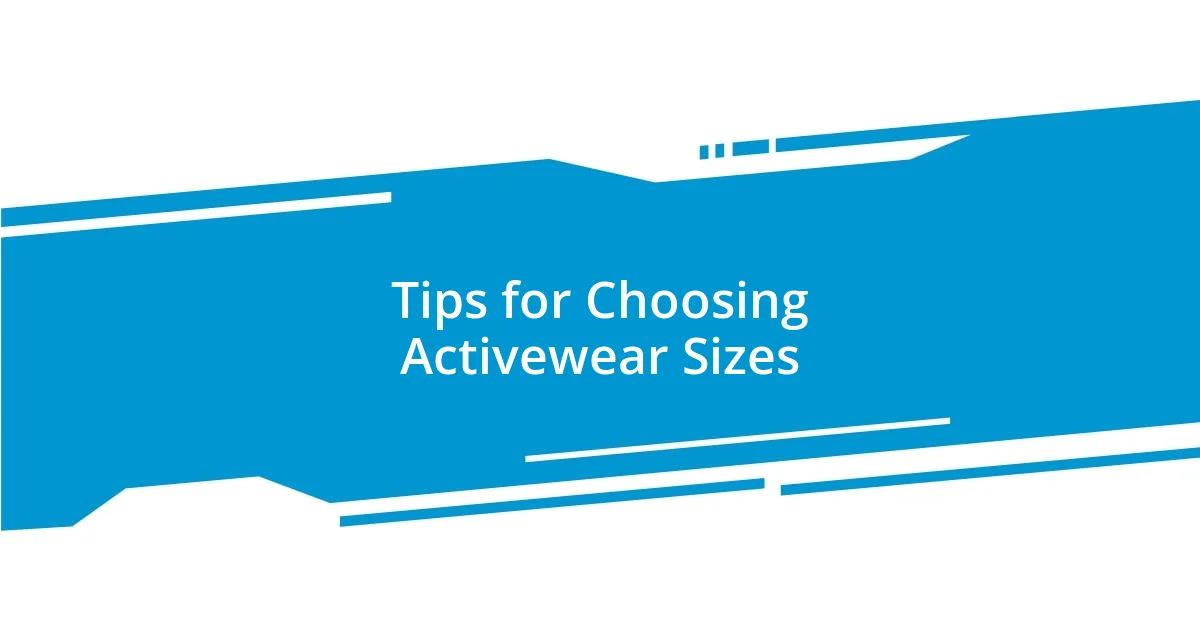
Tips for Choosing Activewear Sizes
Choosing the right size in activewear can make a world of difference in your running experience. As I discovered during a particularly enlightening shopping trip, sizes can differ significantly across brands. I remember trying on a medium tank top from one brand that felt snug, while a large from another floated on me like a parachute! Have you ever had that frustrating moment where you felt lost in a sea of sizes? Understanding each brand’s sizing chart and trying things on can save you from that.
When it comes to bottoms, I prefer a secure fit that doesn’t restrict movement, especially during long runs. A few years back, I bought a pair of leggings that seemed perfect in the fitting room, only for them to slide down mid-run and ruin my flow. That taught me the importance of a proper waistband and fabric elasticity. Have you ever experienced that unexpected wardrobe malfunction? Now, I always opt for styles with adjustable elements or higher waistbands for a more comfortable fit.
It’s also essential to consider how you plan to use your activewear—do you prefer a snug fit for colder weather or a looser, breathable style for summer runs? I vividly recall an early morning jog when I chose a tight-fitting top, which turned into an uncomfortable ride as the sun rose. That day cemented my belief in selecting breathable fabrics for warm conditions. Think about your own preferences; how does your choice of fit influence your performance and comfort on the run?
